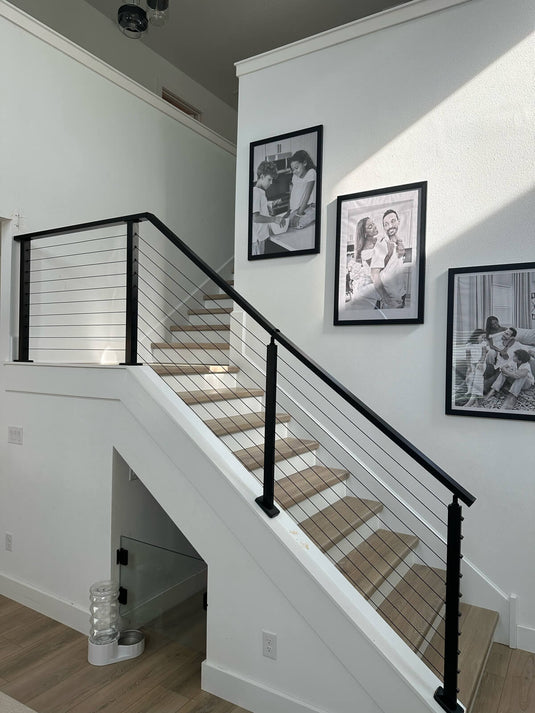TABLE OF CONTENTS
Coastal Living Guide: Ensuring Corrosion Resistance for Your Stainless Cable Railing
Living by the coast is the dream, right? The sound of the waves, the salty air—it’s a lifestyle that’s hard to beat. To make the most of those amazing views, a stainless cable railing is a perfect choice. It’s sleek, modern, and practically disappears. But that salty air we love so much can be incredibly tough on metal. So, how do you make sure your beautiful new railing doesn't turn into a rusty mess? It all comes down to making a few smart choices from the very beginning.
Why the Coast is So Tough on Metal
Before we get into the fixes, it helps to know what you're up against. The coastal environment is basically a perfect storm for rust. You have three things constantly working together: water (from humidity and rain), oxygen (in the air), and salt (from sea spray). When these three team up on a metal surface, they kick off a chemical reaction that creates corrosion, and it happens way faster than it would further inland.
Now, you might be thinking, "But it's stainless steel." That’s a common misunderstanding. "Stainless" doesn't mean it's impossible to stain; it just means it stains less. Without the right type of material and a little bit of care, even high-quality stainless steel can start to show rust-colored blemishes in a salty environment.

The #1 Rule: Choose the Right Grade of Stainless Steel
This is, without a doubt, the most important decision you will make. Getting this right is 90% of the battle. Not all stainless steel is created equal, and for a coastal application, you need a specific type to ensure long-term corrosion resistance.
Type 304 vs. Type 316: What's the Difference?
You’ll typically see two main types of stainless steel used for railings: Type 304 and Type 316. Type 304 is the most common and is perfectly fine for most inland or indoor applications. It’s a great, durable material.
However, Type 316 is what’s known as "marine grade." It has an extra ingredient called molybdenum. This addition dramatically boosts its corrosion resistance, especially against chlorides—which is exactly what's in saltwater. For any stainless cable railing that will be exposed to salt spray, Type 316 is the only real choice.
How to Be Sure You're Getting Type 316
Reputable suppliers will clearly label their products. When you're shopping for your system, look specifically for "Type 316" or "marine-grade" in the product description. It might cost a little more upfront than 304, but trying to save a few dollars here will cost you much more in headaches, cleaning, and replacement parts down the road. This is not the place to cut corners.
Installation Matters: Avoiding Common Corrosion Traps
Even with the best marine-grade material, a poor installation can create weak spots where corrosion can take hold. A little care during the installation process goes a long way.
Avoid Contamination with Other Metals
Have you ever heard of galvanic corrosion? It sounds complicated, but it’s simple: when two different types of metal touch in the presence of saltwater, one will corrode much faster to "protect" the other. To avoid this, don't let regular steel touch your new railing components.
This means using stainless steel tools when possible. More importantly, never cut or grind regular carbon steel anywhere near your stainless steel parts. Tiny iron particles can fly off, embed themselves in the stainless surface, and then rust, creating ugly and damaging spots on your otherwise perfect stainless cable railing.
The Importance of a Clean Finish
High-quality stainless steel has a passive, invisible layer on its surface that protects it from the elements. This layer can be disturbed during shipping or installation. Giving all the components a good cleaning with a specialized cleaner after installation helps to chemically clean the surface and restore this protective layer, a process called passivation. This gives your railing's corrosion resistance a fresh start.

The Secret Weapon: Regular Cleaning and Maintenance
By the coast, you can't just install your railing and forget about it. The secret to keeping it looking brand new for years is a simple, regular cleaning routine.
Why Cleaning is So Important
As salt spray dries on your railing, it leaves behind tiny salt deposits. These deposits aren't just an eyesore; they are trouble. They trap moisture against the metal and concentrate the corrosive chlorides, which can eventually break down that protective layer and cause pitting or tea staining. Regular cleaning washes these deposits away before they can do any damage.
Your Simple Cleaning Routine
You don’t need a complicated routine. Consistency is what really matters.
- Frequent Rinses: Every few weeks, just give the whole railing a good rinse with fresh water from your garden hose. This is the easiest and most effective thing you can do.
- Occasional Wash: Every few months, or whenever it looks grimy, wash it down with some mild dish soap and warm water, using a soft cloth. Just be sure to rinse it thoroughly with fresh water afterward.
-
What to Avoid: Never use harsh scrubbers like steel wool, or harsh chemicals like bleach. These will scratch the surface and destroy its natural corrosion resistance.
What to Do If You See Signs of Corrosion
Even with Type 316 stainless steel, you might eventually see some light brown discoloration, sometimes called "tea staining." Don't panic! If you catch it early, this is usually just a surface issue and doesn't mean your railing is failing.
First, try cleaning the spot with a mild abrasive cleaner and a soft pad. Always rub gently in the direction of the metal's grain to avoid scratching it. Once the spots are gone, rinse the area thoroughly with fresh water. For extra credit, you can apply a special protectant wax or corrosion inhibitor to help seal the surface from the salt air.

Conclusion
A stainless cable railing is a fantastic addition to any coastal home, offering killer style and an unbeatable view. Its survival in such a tough environment really comes down to a simple formula: start with the right stuff (Type 316), be careful when you install it, and stick to a simple cleaning routine. By following these steps, you can be sure your investment will stand up to the salty air and look awesome for years to come.




